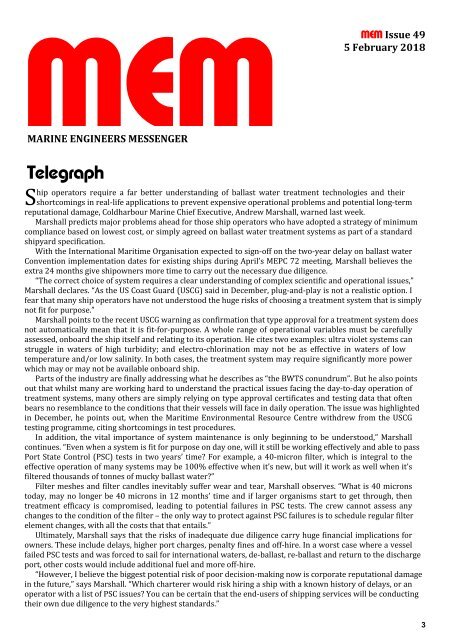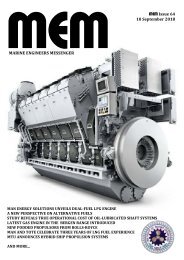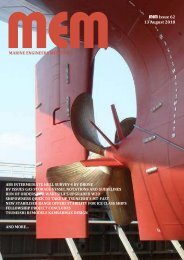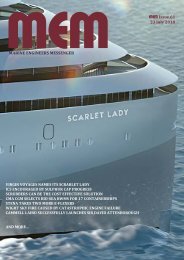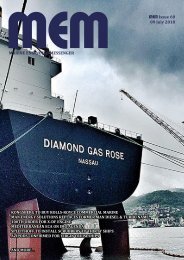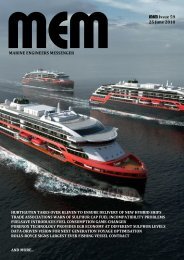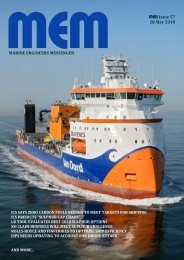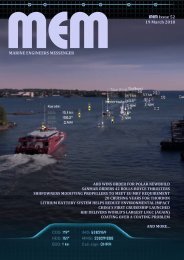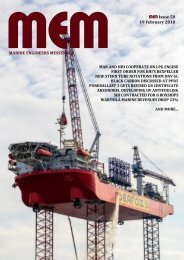MEM49
Marine Engineers Messenger, Volume 3, Issue 49
Marine Engineers Messenger, Volume 3, Issue 49
- No tags were found...
You also want an ePaper? Increase the reach of your titles
YUMPU automatically turns print PDFs into web optimized ePapers that Google loves.
MEM<br />
MARINE ENGINEERS MESSENGER<br />
MEM Issue 49<br />
5 February 2018<br />
Telegraph<br />
S<br />
hip operators require a far better understanding of ballast water treatment technologies and their<br />
shortcomings in real-life applications to prevent expensive operational problems and potential long-term<br />
reputational damage, Coldharbour Marine Chief Executive, Andrew Marshall, warned last week.<br />
Marshall predicts major problems ahead for those ship operators who have adopted a strategy of minimum<br />
compliance based on lowest cost, or simply agreed on ballast water treatment systems as part of a standard<br />
shipyard specification.<br />
With the International Maritime Organisation expected to sign-off on the two-year delay on ballast water<br />
Convention implementation dates for existing ships during April’s MEPC 72 meeting, Marshall believes the<br />
extra 24 months give shipowners more time to carry out the necessary due diligence.<br />
“The correct choice of system requires a clear understanding of complex scientific and operational issues,”<br />
Marshall declares. “As the US Coast Guard (USCG) said in December, plug-and-play is not a realistic option. I<br />
fear that many ship operators have not understood the huge risks of choosing a treatment system that is simply<br />
not fit for purpose.”<br />
Marshall points to the recent USCG warning as confirmation that type approval for a treatment system does<br />
not automatically mean that it is fit-for-purpose. A whole range of operational variables must be carefully<br />
assessed, onboard the ship itself and relating to its operation. He cites two examples: ultra violet systems can<br />
struggle in waters of high turbidity; and electro-chlorination may not be as effective in waters of low<br />
temperature and/or low salinity. In both cases, the treatment system may require significantly more power<br />
which may or may not be available onboard ship.<br />
Parts of the industry are finally addressing what he describes as “the BWTS conundrum”. But he also points<br />
out that whilst many are working hard to understand the practical issues facing the day-to-day operation of<br />
treatment systems, many others are simply relying on type approval certificates and testing data that often<br />
bears no resemblance to the conditions that their vessels will face in daily operation. The issue was highlighted<br />
in December, he points out, when the Maritime Environmental Resource Centre withdrew from the USCG<br />
testing programme, citing shortcomings in test procedures.<br />
In addition, the vital importance of system maintenance is only beginning to be understood,” Marshall<br />
continues. “Even when a system is fit for purpose on day one, will it still be working effectively and able to pass<br />
Port State Control (PSC) tests in two years’ time? For example, a 40-micron filter, which is integral to the<br />
effective operation of many systems may be 100% effective when it’s new, but will it work as well when it’s<br />
filtered thousands of tonnes of mucky ballast water?”<br />
Filter meshes and filter candles inevitably suffer wear and tear, Marshall observes. “What is 40 microns<br />
today, may no longer be 40 microns in 12 months’ time and if larger organisms start to get through, then<br />
treatment efficacy is compromised, leading to potential failures in PSC tests. The crew cannot assess any<br />
changes to the condition of the filter – the only way to protect against PSC failures is to schedule regular filter<br />
element changes, with all the costs that that entails.”<br />
Ultimately, Marshall says that the risks of inadequate due diligence carry huge financial implications for<br />
owners. These include delays, higher port charges, penalty fines and off-hire. In a worst case where a vessel<br />
failed PSC tests and was forced to sail for international waters, de-ballast, re-ballast and return to the discharge<br />
port, other costs would include additional fuel and more off-hire.<br />
“However, I believe the biggest potential risk of poor decision-making now is corporate reputational damage<br />
in the future,” says Marshall. “Which charterer would risk hiring a ship with a known history of delays, or an<br />
operator with a list of PSC issues? You can be certain that the end-users of shipping services will be conducting<br />
their own due diligence to the very highest standards.”<br />
3


